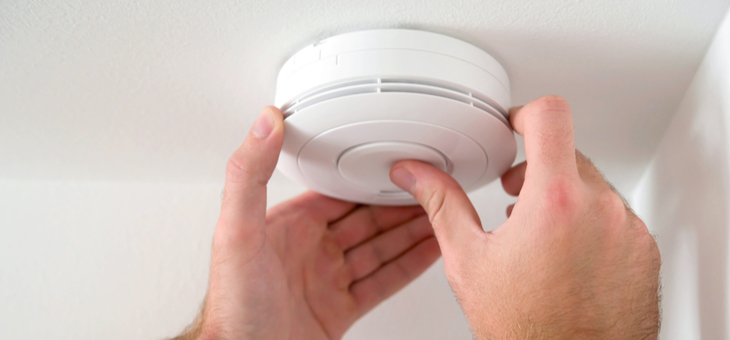More than 12,000 fires occurred in Australian households last year, according to state and territory fire authorities. And new research reveals that half of households surveyed did not test their smoke alarms every month, as recommended, and were not aware that many smoke alarms needed to be replaced periodically.
The findings were revealed in a survey of 1010 Australians commissioned by comparethemarket.com.au.
The survey found that 49 per cent of respondents admitted that, in the month prior, they did not check that every smoke alarm in their home worked. It also revealed that younger Australians were taking more fire risks than other age groups: 56 per cent of under-44s did not check their smoke alarms, compared with 43 per cent of 55–64-year-olds, and 40 per cent of over-65s.
NSW Fire and Rescue (NSWFR) warns that you are twice as likely to die in a home fire if you don’t have a working smoke alarm. Here’s what you need to know about your smoke alarms.
All alarms must have a serial or batch number to indicate when they were manufactured. And Australian Standard 3768 – a standard for the operation and functioning of smoke alarms in Australia – requires all types of smoke alarms to be removed, replaced and disposed of at least every 10 years because they can be affected by dust, insects, humidity and age. “Importantly, technology has also evolved and improved over this time,” says NSWFR. However, the survey showed that 48 per cent of Australians did not know many smoke alarms had expiry dates.
Across the country, WA households were found to be most lax in monitoring their smoke alarms. More than half (56 per cent) of WA households had not checked their smoke alarms, compared with 51 per cent of Victorians, 48 per cent of NSW respondents and 47 per cent of ACT residents.
Which smoke alarm is best?
There are three types of smoke alarms – ionisation, photoelectric and combination ionisation/photoelectric.
An ionisation smoke alarm has a small amount of radioactive material. This radiation passes through an air-filled space between two electrodes, called an ionisation chamber, and allows a small, constant current between the electrodes.
A photoelectric smoke alarm operates using a light source. There is a light-sensing chamber inside the alarm; an LED light shoots a beam of light across the chamber. When smoke enters the chamber, it deflects the LED light from the straight path into a photosensor in a different compartment inside the chamber, causing the alarm to set off. This works best on a slow smouldering fire.
FRNSW recommends that wherever possible, hard-wired and interconnected smoke alarms be installed.
If your alarms cannot be hard-wired, FRNSW recommends smoke alarms that rely on 10-year lithium batteries. It says that inbuilt 10-year lithium batteries last as long as the smoke alarm, so you don’t need to worry about replacing them every year – you simply replace the entire smoke alarm unit once every 10 years.
Consumer advocate CHOICE reports: “Studies have shown that photoelectric alarms typically respond to smoky fires within about three to five minutes. Ionisation alarms can take much longer – up to 20 minutes or more – by which time escape can be much more difficult.”
Where should smoke alarms be positioned?
There are minimum requirements in building codes, but FRNSW recommends a higher level of protection with the installation of interconnected alarms in every bedroom, living space (including hallways and stairways) and even your garage.
How should residents maintain their smoke alarms?
FRNSW recommends the following maintenance checks.
- Every month: Smoke alarms should be tested (by pressing the test button) to ensure the battery and the alarm work.
- Every six months: Smoke alarms should be cleaned with a vacuum cleaner. This will remove any dust or particles that could prevent the smoke alarm from working properly.
- Once a year: If your smoke alarm has a battery, you should replace it annually. A good way to remember is to change it when you change your clocks at the end of daylight saving. If your smoke alarm uses a lithium battery, it is inbuilt into the alarm and cannot be replaced. The entire unit needs to be replaced every 10 years.
- Every 10 years: Replace your smoke alarm. Smoke alarms do not last forever and the sensitivity in all smoke alarms will reduce over time. All types of smoke alarms should be removed, replaced and disposed of at least every 10 years.
What if I’m hard of hearing?
Strobe light and vibrating pad smoke alarms are available for people who are deaf or hard of hearing. More information is available here.
Do you religiously check your alarms as recommended above?
If you enjoy our content, don’t keep it to yourself. Share our free eNews with your friends and encourage them to sign up.
Related articles:
https://www.yourlifechoices.com.au/health/wellbeing/make-your-happy-home-a-healthy-one
https://www.yourlifechoices.com.au/finance/seniors-finance/cheap-versus-expensive-frypans
https://www.yourlifechoices.com.au/finance/property/tips-for-painting-interior-woodwork

